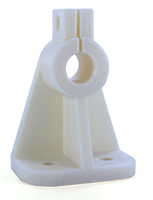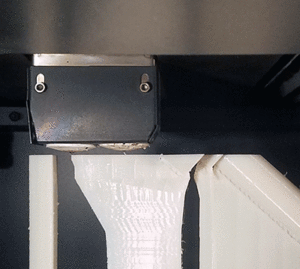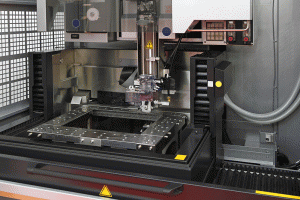ULTEM is a highly durable material that is widely used in industries we encounter every day. Its high-performance mechanical properties allow it to be used in extreme temperatures and harsh conditions. In this article, we’ll detail what ULTEM is, its applications, the challenges to 3D printing with ULTEM, and possible alternative materials.
What is ULTEM?
ULTEM is a rigid, lightweight thermoplastic from the Polyetherimide (PEI) family. This amorphous, high-performance polymer is heat, flame, UV, and solvent resistant, making it prime for high-stress environments and outdoor use. While ULTEM is hydrolytic and can withstand exposure to steam and submersion in  boiling water, it is not recommended that the material come into contact with alkaline materials or solvents because it is vulnerable to this chemical category.
boiling water, it is not recommended that the material come into contact with alkaline materials or solvents because it is vulnerable to this chemical category.
This material has excellent dimensional stability and is often used in work conditions where durability in extreme heat is necessary. ULTEM boasts a glass transition temperature of 367°F, continuous use up to 340°F, and a heat deflection temperature of 307°F, all of which are much higher than that of most other thermoplastics. Additionally, its strength-to-weight ratio makes it a suitable substitute for aluminum parts.
ULTEM can be 3D printed, machined, and injection molded, making its incorporation into many industries easy. The primary industries that utilize ULTEM are aerospace, automotive, electrical, medical, and culinary.
Aerospace
ULTEM has received many certifications for use in aircraft, including one from the Federal Aviation Administration. This is largely due to the material’s flame retardancy, low smoke emission and low toxicity. Its use in this industry is also owed to its strength-to-weight ratio, which makes it a great fit for airplanes’ requirement of high strength and low weight for fuel efficiency. Currently, ULTEM is not used in any critical areas of the industry. Instead, it is used for noncritical parts, such as vents, cables, latches, door handles, and other small components.
Automotive & Electrical
ULTEM’s chemical and heat resistance makes it an excellent material for use in the automotive and electrical industries. These industries have demanding conditions, such as contact with oil, grease, and other automotive fluids, as well as elevated temperatures. With its high operating temperature and solvent resistance, ULTEM has been used as a substitute for both steel and aluminum to maximize fuel efficiency in the automotive industry. Between these two industries, ULTEM is used for cables, connectors, levers, engine components, lighting, and much more.
Medical & Culinary
Another use for ULTEM is the food and medical industries. ULTEM is certified for use in food production and medical environments. It is biocompatible and can be used for custom tools and fixtures, baking equipment, trays, and more. Additionally, ULTEM is able to be sterilized, including through autoclaving for medical sterilization.
3D Printing with ULTEM
 Filament Extrusion (FDM)
Filament Extrusion (FDM)
3D printing ULTEM via filament extrusion is a bit trickier than most basic filaments. This is due to ULTEM’s high melting temperature, which requires that the 3D printer work with much higher temperatures than normal. Because of this, the printer must have an all metal print head and be capable of keeping the build chamber at a uniform temperature. If the heat is not distributed evenly, the ULTEM may cool too much during a print job, causing the material to shrink or warp, disrupting layer adhesion, and resulting in a weak part. With this high demand on the printer, many service providers don’t offer ULTEM filament or print it, which makes this material more expensive than other 3D printing materials.
In addition to temperature demands during printing, post-processing an ULTEM part can pose some problems. ULTEM’s support must be durable and have a high enough heat resistance to survive ULTEM’s printing temperature in the build chamber. This means that the support cannot simply be dissolved or melted away. Instead, it must be removed manually by breaking it or chipping it away. This can damage fine features and takes much more time to remove than water soluble support. However, due to ULTEM’s strength, some parts may be able to be oriented in such a way to use less support material. Furthermore, if a particular surface finish is also desired, extra time must be allowed. Due to ULTEM’s durability, sanding and surface finishes take longer than with more common 3D printing materials.
Selective Laser Sintering (SLS)
Selective laser sintering of ULTEM can be just as difficult as filament extrusion. Due to the elevated temperature demands of ULTEM, the laser must be able to maintain constant heat to melt a cohesive layer. The supporting powder, however, is much easier to remove than the support material used in filament extrusion.
Despite these drawbacks in the process, 3D printing ULTEM is worthwhile for the durability and other high-performance properties it possess. Both strong functional prototypes and end use parts can be produced on demand without the tooling cost or lead times that come with the machining and molding processes.
Manufacturing with ULTEM
If you plan to make a large volume of your part, it may be best to consider machining or injection molding. Both of these processes are better suited for large productions where the necessity of speed and quantity outweigh the tooling and excess material cost.
 Machining ULTEM can take more time than other materials because it must be annealed prior to cutting. This will help relieve internal stresses that could result in a weak part. Also, because ULTEM is so tough, it requires high-speed steel cutting tools to achieve the best results.
Machining ULTEM can take more time than other materials because it must be annealed prior to cutting. This will help relieve internal stresses that could result in a weak part. Also, because ULTEM is so tough, it requires high-speed steel cutting tools to achieve the best results.
For injection molding ULTEM, proper material preparation is also needed. Again, working with ULTEM will take longer than another material because it must be pre-dried to prevent weaknesses in the parts. Like controlling a uniform heat in the 3D printer’s build chamber, high mold temperature must also be maintained.
ULTEM Alternatives
When considering using ULTEM, it is important to keep in mind your part’s intended use. While ULTEM is highly durable and can withstand extreme temperatures, it may not be exactly what you require. If you find ULTEM won’t suit your needs, there are alternatives that may be worth considering. The top two alternatives to ULTEM are PEEK and PPSF.
PEEK
PEEK (Polyether ether ketone) is a semi-crystalline thermoplastic that possesses many of the same mechanical properties as ULTEM. It excels in high-stress environments where such stress might cause ULTEM to break. While this material is more expensive than ULTEM, this material can add the extra strength you need if your part must endure high stress for long periods of time. However, PEEK is not readily available to be 3D printed and relies on injection molding and machining to produce parts. To learn more about PEEK, click here.
PPSF
While ULTEM and PEEK have superior strength to PPSF, this material still possesses more durability than most other 3D printing plastics. It offers heat resistance comparable to ULTEM with the added benefit of being self-extinguishing, making it ideal for application involving open flames or high friction.
PEEK ULTEM 9085 PPSF
Tensile Strength 14,210 psi 9,950 psi 8,000 psi
Tensile Modulus 580,150 psi 329,000 psi 300,000 psi
Flexural Strength 23,930 psi 16,200 psi 15,900 psi
Flexural Modulus 551,143 psi 331,000 psi 320,000 psi
HDT 306°F 307°F 372°F
Glass Transition 289°F 367°F 446°F
3D Printing at 3 Space
Here at 3 Space, we offer a variety of printing materials for filament extrusion 3D printing, including both ULTEM and PPSF. If you’re uncertain whether one of these materials will satisfy your needs, our technicians can aid you in material selection by suggesting the best material based on your part’s intended use. For more information, contact us today.
